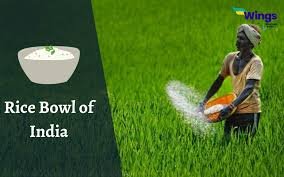An In-depth Look at India’s Rice Bowl: Andhra Pradesh and Telangana
India, known for its diverse agricultural heritage, has certain regions famous for their specific crops. One such region is often referred to as the “Rice Bowl of India.” This term specifically highlights Andhra Pradesh and Telangana, two states renowned for their extensive rice production. Understanding the significance of this region is crucial for various government exams, especially those related to agriculture, geography, and economic development.
Why Andhra Pradesh and Telangana?
Andhra Pradesh and Telangana contribute significantly to India’s rice production due to their favorable climate, fertile soil, and efficient irrigation systems. The Godavari and Krishna rivers play a pivotal role in providing the necessary water resources. This region’s agricultural efficiency is enhanced by the use of traditional and modern farming techniques, making it a cornerstone of India’s rice supply.
Agricultural Practices in the Region
The farmers in Andhra Pradesh and Telangana employ a combination of age-old practices and innovative techniques to maximize yield. The use of high-yield variety seeds, proper crop rotation, and advanced irrigation methods such as drip and sprinkler systems ensure sustained productivity. Additionally, government initiatives and subsidies have further bolstered rice production in these states.
Economic Impact
Rice farming in Andhra Pradesh and Telangana significantly impacts the local and national economy. It provides employment to millions, supports related industries, and contributes to the overall GDP. The states also play a crucial role in maintaining food security in India, ensuring a stable supply of this staple food.
Challenges and Future Prospects
Despite their success, these regions face challenges such as water scarcity, soil degradation, and the impacts of climate change. However, ongoing research and development, along with governmental support, are paving the way for sustainable agricultural practices. Innovations in biotechnology and increased focus on organic farming are expected to enhance the resilience and productivity of rice cultivation in the future.

Why This News Is Important
Significance for Agricultural Exams
For students preparing for agricultural exams, understanding the role of Andhra Pradesh and Telangana in rice production is crucial. It provides insights into crop management, irrigation techniques, and the economic implications of agriculture.
Relevance to Geography Studies
Geography students can gain valuable knowledge about the physical and climatic conditions that make these states ideal for rice farming. This understanding helps in comprehending the broader agricultural patterns across India.
Economic and Policy Implications
For exams focusing on economics and public policy, this news highlights the interplay between agriculture and economic development. It also sheds light on government policies that support agriculture, crucial for public administration roles.
Historical Context
The term “Rice Bowl of India” has been associated with Andhra Pradesh and Telangana for decades. Historically, these regions have been at the forefront of rice cultivation due to their fertile deltas formed by the Godavari and Krishna rivers. Over the years, advancements in agricultural techniques and government support have solidified their position as major rice producers. The Green Revolution in the 1960s further boosted rice production through the introduction of high-yield varieties and better irrigation practices.
Key Takeaways from “India’s Rice Bowl: Andhra Pradesh and Telangana”
| Serial Number | Key Takeaway |
|---|---|
| 1 | Andhra Pradesh and Telangana are known as the “Rice Bowl of India.” |
| 2 | The Godavari and Krishna rivers provide essential irrigation. |
| 3 | Advanced farming techniques are employed for high yield. |
| 4 | Rice farming significantly contributes to the local and national economy. |
| 5 | Challenges include water scarcity and climate change impacts, with ongoing efforts for sustainable practices. |
Important FAQs for Students from this News
Q: Why are Andhra Pradesh and Telangana called the “Rice Bowl of India”?
- A: These states are known for their extensive rice cultivation, contributing significantly to India’s overall rice production.
Q: What are some factors contributing to the success of rice farming in these regions?
- A: Factors include favorable climate, fertile soil, efficient irrigation from rivers like the Godavari and Krishna, and the adoption of modern farming techniques.
Q: How does rice farming impact the economy of Andhra Pradesh and Telangana?
- A: Rice farming provides employment, supports related industries, and contributes to the states’ GDP, thus playing a crucial role in their economic development.
Q: What challenges do these regions face in rice production?
- A: Challenges include water scarcity, soil degradation, and the impacts of climate change, which necessitate sustainable farming practices.
Q: What measures are being taken to address the challenges in rice farming?
- A: Ongoing research, government initiatives, and the adoption of innovative practices such as biotechnology and organic farming aim to ensure the sustainability of rice cultivation.
Some Important Current Affairs Links


















